FIN303 Financial Management: Evaluating Loan Terms and Investments
VerifiedAdded on 2023/06/04
|10
|1501
|408
Homework Assignment
AI Summary
This assignment delves into various aspects of financial management, beginning with a detailed analysis of an $800,000 loan, including calculations of interest paid in the first month of the 25th year and the total interest paid over the loan's lifetime. It interprets these findings and discusses limitations, further calculating the present value of loan payments using a specified discount rate. The assignment then transitions to evaluating the weighted average cost of capital (WACC) for T. Holdings, justifying a suitable discount rate and computing operating cash flow and net working capital for a project over five years to determine its net present value (NPV), ultimately providing investment recommendations. Finally, it examines Maureen's dividend policy and the impact of changes in capital structure, assessing scenarios with and without taxes to determine the relevance of capital structure decisions, supported by calculations of dividend per share and shares repurchased under different conditions. The document is available on Desklib, a platform offering a range of AI-based study tools and resources for students.
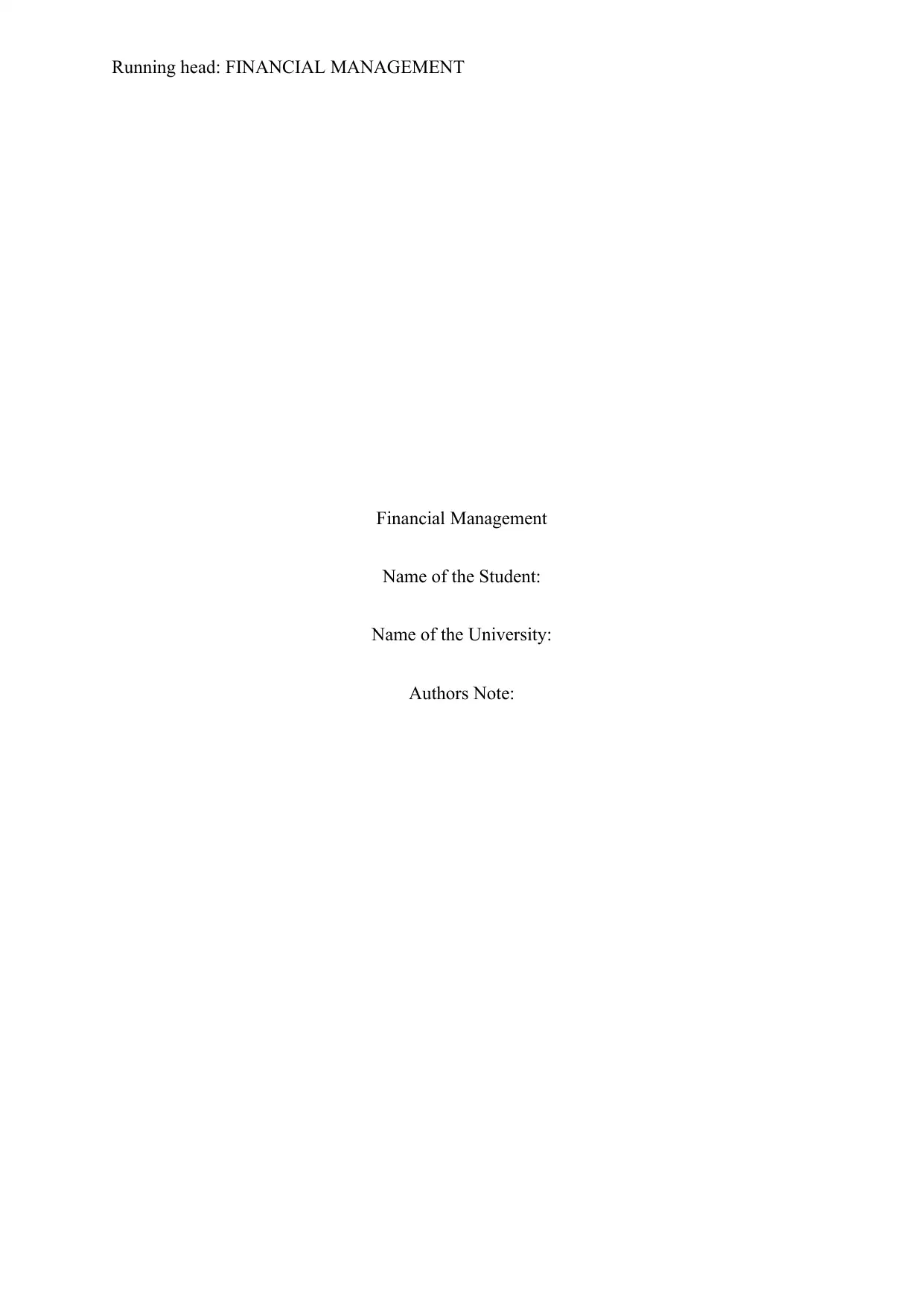
Running head: FINANCIAL MANAGEMENT
Financial Management
Name of the Student:
Name of the University:
Authors Note:
Financial Management
Name of the Student:
Name of the University:
Authors Note:
Paraphrase This Document
Need a fresh take? Get an instant paraphrase of this document with our AI Paraphraser
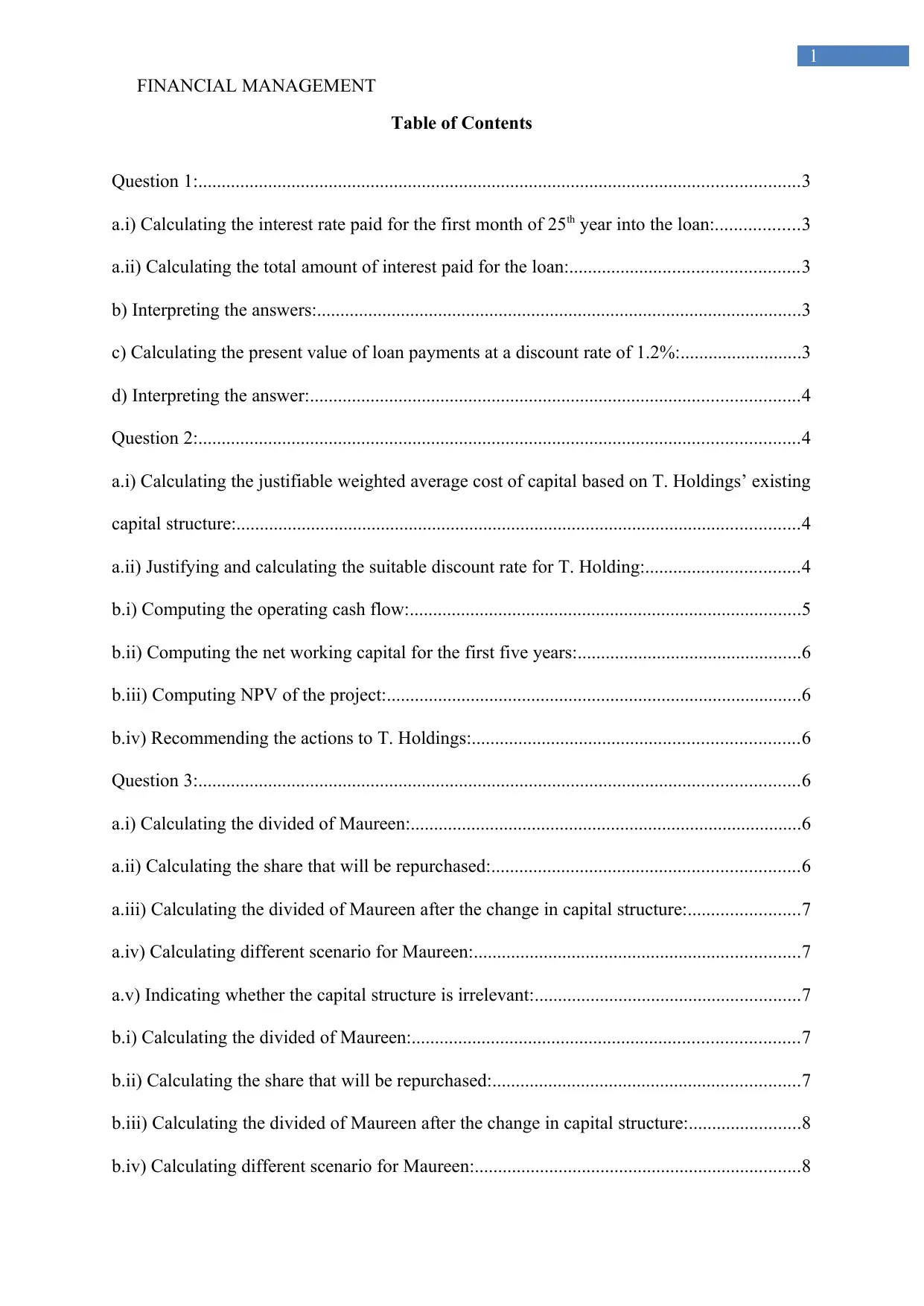
FINANCIAL MANAGEMENT
1
Table of Contents
Question 1:.................................................................................................................................3
a.i) Calculating the interest rate paid for the first month of 25th year into the loan:..................3
a.ii) Calculating the total amount of interest paid for the loan:.................................................3
b) Interpreting the answers:........................................................................................................3
c) Calculating the present value of loan payments at a discount rate of 1.2%:..........................3
d) Interpreting the answer:.........................................................................................................4
Question 2:.................................................................................................................................4
a.i) Calculating the justifiable weighted average cost of capital based on T. Holdings’ existing
capital structure:.........................................................................................................................4
a.ii) Justifying and calculating the suitable discount rate for T. Holding:.................................4
b.i) Computing the operating cash flow:....................................................................................5
b.ii) Computing the net working capital for the first five years:................................................6
b.iii) Computing NPV of the project:.........................................................................................6
b.iv) Recommending the actions to T. Holdings:......................................................................6
Question 3:.................................................................................................................................6
a.i) Calculating the divided of Maureen:....................................................................................6
a.ii) Calculating the share that will be repurchased:..................................................................6
a.iii) Calculating the divided of Maureen after the change in capital structure:........................7
a.iv) Calculating different scenario for Maureen:......................................................................7
a.v) Indicating whether the capital structure is irrelevant:.........................................................7
b.i) Calculating the divided of Maureen:...................................................................................7
b.ii) Calculating the share that will be repurchased:..................................................................7
b.iii) Calculating the divided of Maureen after the change in capital structure:........................8
b.iv) Calculating different scenario for Maureen:......................................................................8
1
Table of Contents
Question 1:.................................................................................................................................3
a.i) Calculating the interest rate paid for the first month of 25th year into the loan:..................3
a.ii) Calculating the total amount of interest paid for the loan:.................................................3
b) Interpreting the answers:........................................................................................................3
c) Calculating the present value of loan payments at a discount rate of 1.2%:..........................3
d) Interpreting the answer:.........................................................................................................4
Question 2:.................................................................................................................................4
a.i) Calculating the justifiable weighted average cost of capital based on T. Holdings’ existing
capital structure:.........................................................................................................................4
a.ii) Justifying and calculating the suitable discount rate for T. Holding:.................................4
b.i) Computing the operating cash flow:....................................................................................5
b.ii) Computing the net working capital for the first five years:................................................6
b.iii) Computing NPV of the project:.........................................................................................6
b.iv) Recommending the actions to T. Holdings:......................................................................6
Question 3:.................................................................................................................................6
a.i) Calculating the divided of Maureen:....................................................................................6
a.ii) Calculating the share that will be repurchased:..................................................................6
a.iii) Calculating the divided of Maureen after the change in capital structure:........................7
a.iv) Calculating different scenario for Maureen:......................................................................7
a.v) Indicating whether the capital structure is irrelevant:.........................................................7
b.i) Calculating the divided of Maureen:...................................................................................7
b.ii) Calculating the share that will be repurchased:..................................................................7
b.iii) Calculating the divided of Maureen after the change in capital structure:........................8
b.iv) Calculating different scenario for Maureen:......................................................................8
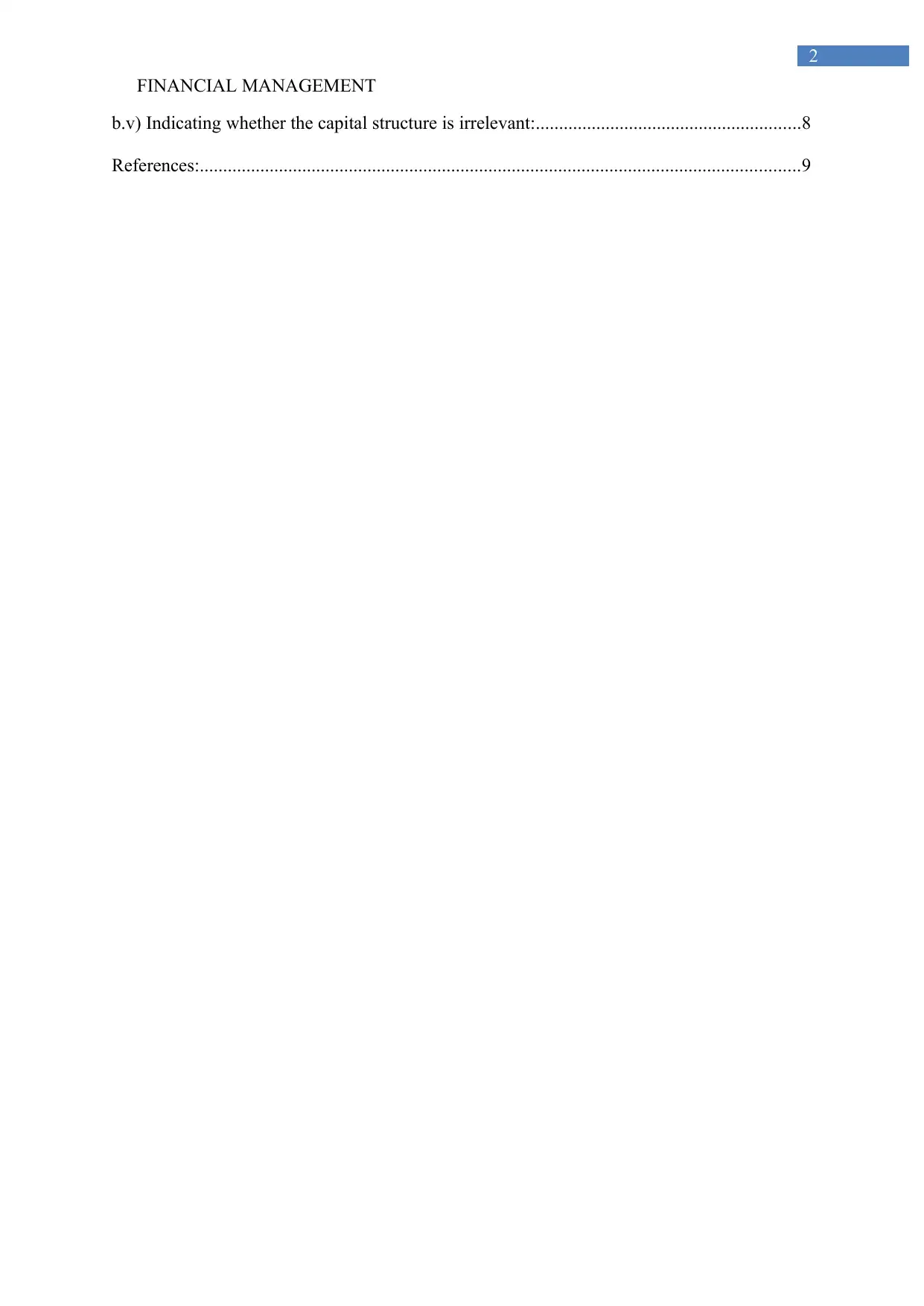
FINANCIAL MANAGEMENT
2
b.v) Indicating whether the capital structure is irrelevant:.........................................................8
References:.................................................................................................................................9
2
b.v) Indicating whether the capital structure is irrelevant:.........................................................8
References:.................................................................................................................................9
⊘ This is a preview!⊘
Do you want full access?
Subscribe today to unlock all pages.

Trusted by 1+ million students worldwide

FINANCIAL MANAGEMENT
3
Question 1:
a.i) Calculating the interest rate paid for the first month of 25th year into the loan:
Particulars Value
Rate 0.30%
Time 360
Amount 800,000
Monthly payment $3,637.16
Particulars Value
Rate 0.30%
Time 288
Amount 800,000
Monthly payment $3,637.16
Loan outstanding after 24 years $235,208.19
Interest paid in 1st month of 25th year $705.62
a.ii) Calculating the total amount of interest paid for the loan:
Particulars Value
Monthly payment $ 3,637.16
Time 360
Amount $ 800,000.00
Total interest paid $ 509,378.61
b) Interpreting the answers:
From the evaluation, it can be detected that the total interest paid during the period of
30 years is approximately 60% of the total loan amount. In addition, the major limitation is
the term of the loan, while the refinancing is also conducted a draw back.
c) Calculating the present value of loan payments at a discount rate of 1.2%:
Particulars Value
Rate 0.10%
Time 360
3
Question 1:
a.i) Calculating the interest rate paid for the first month of 25th year into the loan:
Particulars Value
Rate 0.30%
Time 360
Amount 800,000
Monthly payment $3,637.16
Particulars Value
Rate 0.30%
Time 288
Amount 800,000
Monthly payment $3,637.16
Loan outstanding after 24 years $235,208.19
Interest paid in 1st month of 25th year $705.62
a.ii) Calculating the total amount of interest paid for the loan:
Particulars Value
Monthly payment $ 3,637.16
Time 360
Amount $ 800,000.00
Total interest paid $ 509,378.61
b) Interpreting the answers:
From the evaluation, it can be detected that the total interest paid during the period of
30 years is approximately 60% of the total loan amount. In addition, the major limitation is
the term of the loan, while the refinancing is also conducted a draw back.
c) Calculating the present value of loan payments at a discount rate of 1.2%:
Particulars Value
Rate 0.10%
Time 360
Paraphrase This Document
Need a fresh take? Get an instant paraphrase of this document with our AI Paraphraser
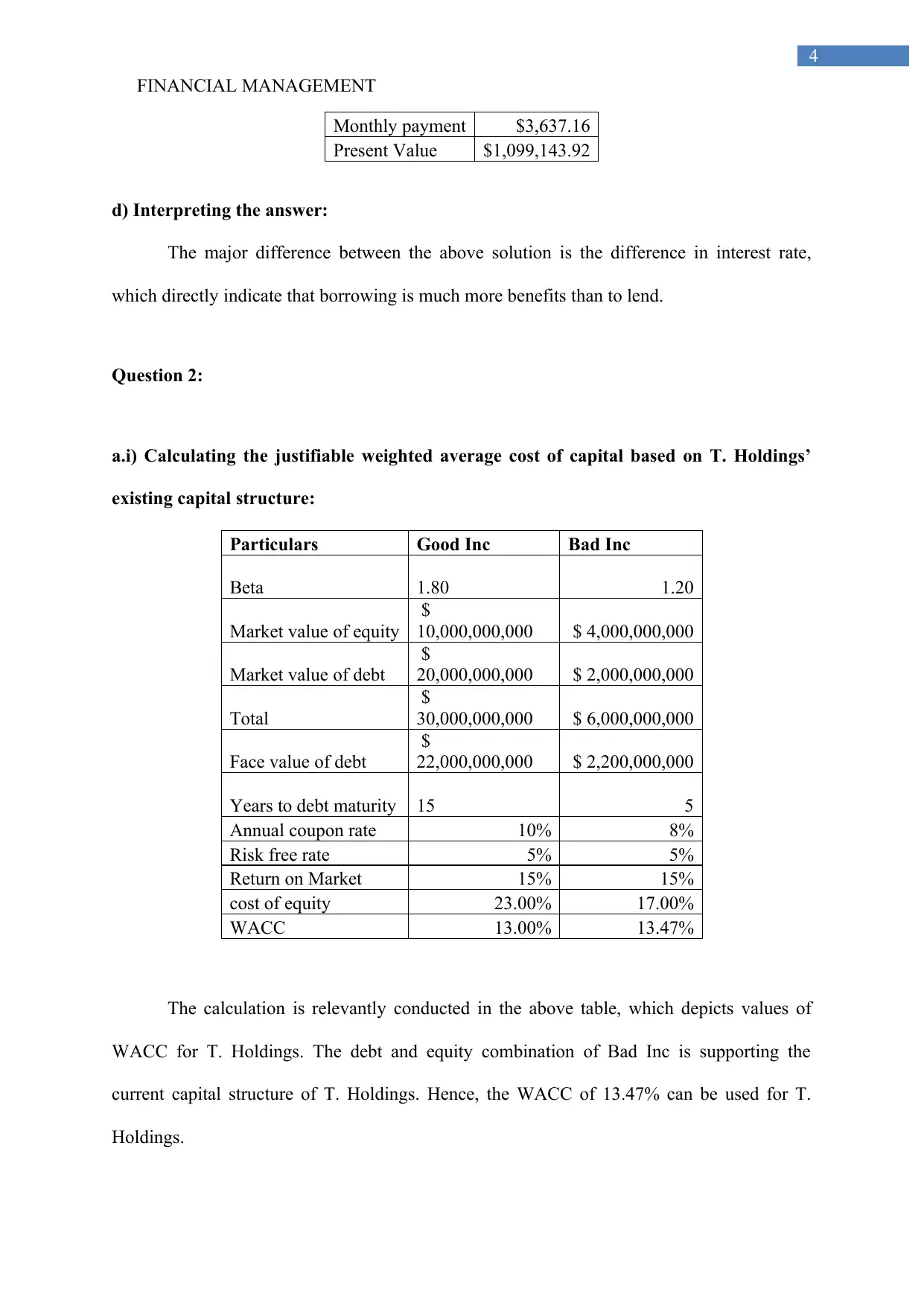
FINANCIAL MANAGEMENT
4
Monthly payment $3,637.16
Present Value $1,099,143.92
d) Interpreting the answer:
The major difference between the above solution is the difference in interest rate,
which directly indicate that borrowing is much more benefits than to lend.
Question 2:
a.i) Calculating the justifiable weighted average cost of capital based on T. Holdings’
existing capital structure:
Particulars Good Inc Bad Inc
Beta 1.80 1.20
Market value of equity
$
10,000,000,000 $ 4,000,000,000
Market value of debt
$
20,000,000,000 $ 2,000,000,000
Total
$
30,000,000,000 $ 6,000,000,000
Face value of debt
$
22,000,000,000 $ 2,200,000,000
Years to debt maturity 15 5
Annual coupon rate 10% 8%
Risk free rate 5% 5%
Return on Market 15% 15%
cost of equity 23.00% 17.00%
WACC 13.00% 13.47%
The calculation is relevantly conducted in the above table, which depicts values of
WACC for T. Holdings. The debt and equity combination of Bad Inc is supporting the
current capital structure of T. Holdings. Hence, the WACC of 13.47% can be used for T.
Holdings.
4
Monthly payment $3,637.16
Present Value $1,099,143.92
d) Interpreting the answer:
The major difference between the above solution is the difference in interest rate,
which directly indicate that borrowing is much more benefits than to lend.
Question 2:
a.i) Calculating the justifiable weighted average cost of capital based on T. Holdings’
existing capital structure:
Particulars Good Inc Bad Inc
Beta 1.80 1.20
Market value of equity
$
10,000,000,000 $ 4,000,000,000
Market value of debt
$
20,000,000,000 $ 2,000,000,000
Total
$
30,000,000,000 $ 6,000,000,000
Face value of debt
$
22,000,000,000 $ 2,200,000,000
Years to debt maturity 15 5
Annual coupon rate 10% 8%
Risk free rate 5% 5%
Return on Market 15% 15%
cost of equity 23.00% 17.00%
WACC 13.00% 13.47%
The calculation is relevantly conducted in the above table, which depicts values of
WACC for T. Holdings. The debt and equity combination of Bad Inc is supporting the
current capital structure of T. Holdings. Hence, the WACC of 13.47% can be used for T.
Holdings.
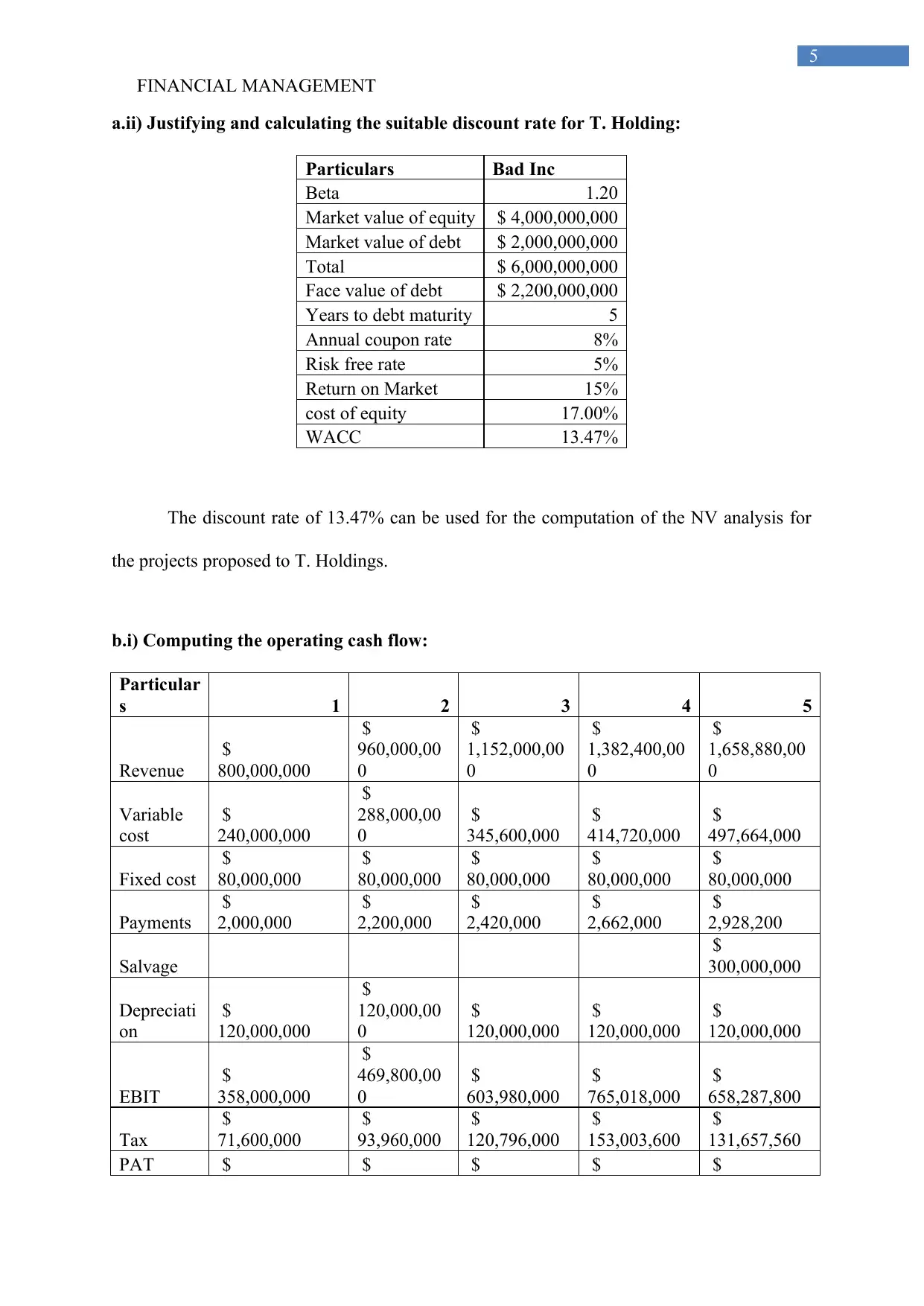
FINANCIAL MANAGEMENT
5
a.ii) Justifying and calculating the suitable discount rate for T. Holding:
Particulars Bad Inc
Beta 1.20
Market value of equity $ 4,000,000,000
Market value of debt $ 2,000,000,000
Total $ 6,000,000,000
Face value of debt $ 2,200,000,000
Years to debt maturity 5
Annual coupon rate 8%
Risk free rate 5%
Return on Market 15%
cost of equity 17.00%
WACC 13.47%
The discount rate of 13.47% can be used for the computation of the NV analysis for
the projects proposed to T. Holdings.
b.i) Computing the operating cash flow:
Particular
s 1 2 3 4 5
Revenue
$
800,000,000
$
960,000,00
0
$
1,152,000,00
0
$
1,382,400,00
0
$
1,658,880,00
0
Variable
cost
$
240,000,000
$
288,000,00
0
$
345,600,000
$
414,720,000
$
497,664,000
Fixed cost
$
80,000,000
$
80,000,000
$
80,000,000
$
80,000,000
$
80,000,000
Payments
$
2,000,000
$
2,200,000
$
2,420,000
$
2,662,000
$
2,928,200
Salvage
$
300,000,000
Depreciati
on
$
120,000,000
$
120,000,00
0
$
120,000,000
$
120,000,000
$
120,000,000
EBIT
$
358,000,000
$
469,800,00
0
$
603,980,000
$
765,018,000
$
658,287,800
Tax
$
71,600,000
$
93,960,000
$
120,796,000
$
153,003,600
$
131,657,560
PAT $ $ $ $ $
5
a.ii) Justifying and calculating the suitable discount rate for T. Holding:
Particulars Bad Inc
Beta 1.20
Market value of equity $ 4,000,000,000
Market value of debt $ 2,000,000,000
Total $ 6,000,000,000
Face value of debt $ 2,200,000,000
Years to debt maturity 5
Annual coupon rate 8%
Risk free rate 5%
Return on Market 15%
cost of equity 17.00%
WACC 13.47%
The discount rate of 13.47% can be used for the computation of the NV analysis for
the projects proposed to T. Holdings.
b.i) Computing the operating cash flow:
Particular
s 1 2 3 4 5
Revenue
$
800,000,000
$
960,000,00
0
$
1,152,000,00
0
$
1,382,400,00
0
$
1,658,880,00
0
Variable
cost
$
240,000,000
$
288,000,00
0
$
345,600,000
$
414,720,000
$
497,664,000
Fixed cost
$
80,000,000
$
80,000,000
$
80,000,000
$
80,000,000
$
80,000,000
Payments
$
2,000,000
$
2,200,000
$
2,420,000
$
2,662,000
$
2,928,200
Salvage
$
300,000,000
Depreciati
on
$
120,000,000
$
120,000,00
0
$
120,000,000
$
120,000,000
$
120,000,000
EBIT
$
358,000,000
$
469,800,00
0
$
603,980,000
$
765,018,000
$
658,287,800
Tax
$
71,600,000
$
93,960,000
$
120,796,000
$
153,003,600
$
131,657,560
PAT $ $ $ $ $
⊘ This is a preview!⊘
Do you want full access?
Subscribe today to unlock all pages.

Trusted by 1+ million students worldwide
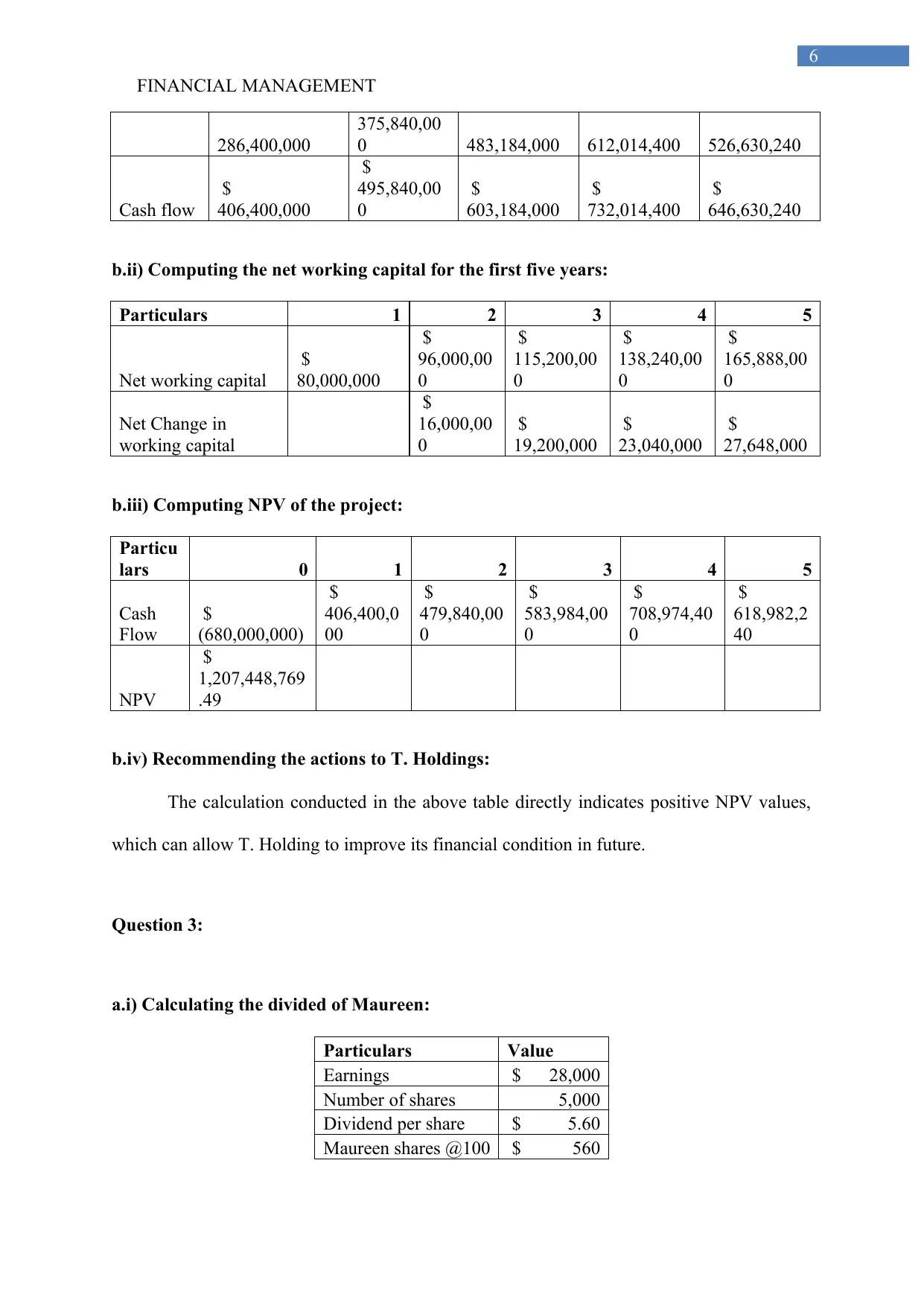
FINANCIAL MANAGEMENT
6
286,400,000
375,840,00
0 483,184,000 612,014,400 526,630,240
Cash flow
$
406,400,000
$
495,840,00
0
$
603,184,000
$
732,014,400
$
646,630,240
b.ii) Computing the net working capital for the first five years:
Particulars 1 2 3 4 5
Net working capital
$
80,000,000
$
96,000,00
0
$
115,200,00
0
$
138,240,00
0
$
165,888,00
0
Net Change in
working capital
$
16,000,00
0
$
19,200,000
$
23,040,000
$
27,648,000
b.iii) Computing NPV of the project:
Particu
lars 0 1 2 3 4 5
Cash
Flow
$
(680,000,000)
$
406,400,0
00
$
479,840,00
0
$
583,984,00
0
$
708,974,40
0
$
618,982,2
40
NPV
$
1,207,448,769
.49
b.iv) Recommending the actions to T. Holdings:
The calculation conducted in the above table directly indicates positive NPV values,
which can allow T. Holding to improve its financial condition in future.
Question 3:
a.i) Calculating the divided of Maureen:
Particulars Value
Earnings $ 28,000
Number of shares 5,000
Dividend per share $ 5.60
Maureen shares @100 $ 560
6
286,400,000
375,840,00
0 483,184,000 612,014,400 526,630,240
Cash flow
$
406,400,000
$
495,840,00
0
$
603,184,000
$
732,014,400
$
646,630,240
b.ii) Computing the net working capital for the first five years:
Particulars 1 2 3 4 5
Net working capital
$
80,000,000
$
96,000,00
0
$
115,200,00
0
$
138,240,00
0
$
165,888,00
0
Net Change in
working capital
$
16,000,00
0
$
19,200,000
$
23,040,000
$
27,648,000
b.iii) Computing NPV of the project:
Particu
lars 0 1 2 3 4 5
Cash
Flow
$
(680,000,000)
$
406,400,0
00
$
479,840,00
0
$
583,984,00
0
$
708,974,40
0
$
618,982,2
40
NPV
$
1,207,448,769
.49
b.iv) Recommending the actions to T. Holdings:
The calculation conducted in the above table directly indicates positive NPV values,
which can allow T. Holding to improve its financial condition in future.
Question 3:
a.i) Calculating the divided of Maureen:
Particulars Value
Earnings $ 28,000
Number of shares 5,000
Dividend per share $ 5.60
Maureen shares @100 $ 560
Paraphrase This Document
Need a fresh take? Get an instant paraphrase of this document with our AI Paraphraser
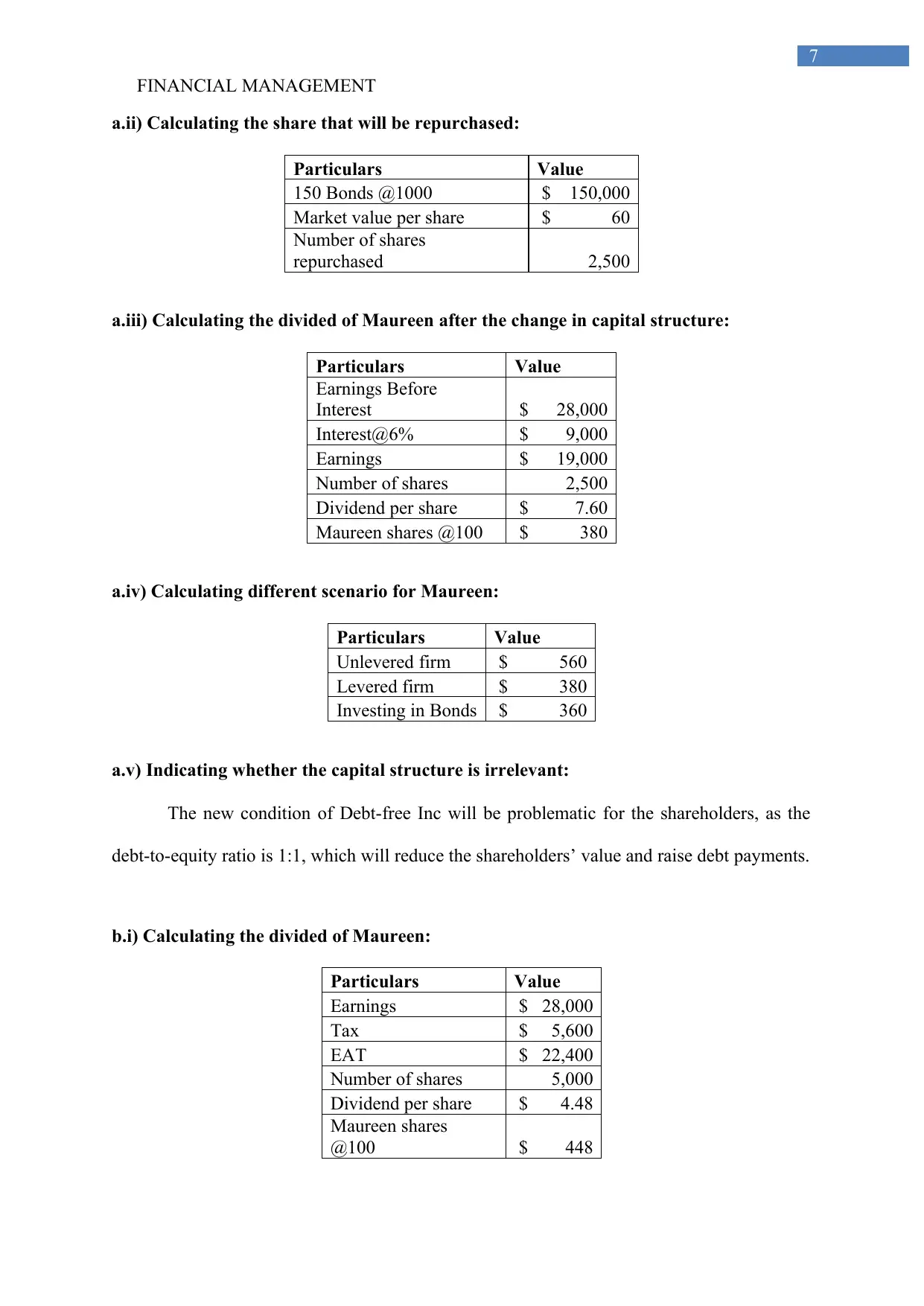
FINANCIAL MANAGEMENT
7
a.ii) Calculating the share that will be repurchased:
Particulars Value
150 Bonds @1000 $ 150,000
Market value per share $ 60
Number of shares
repurchased 2,500
a.iii) Calculating the divided of Maureen after the change in capital structure:
Particulars Value
Earnings Before
Interest $ 28,000
Interest@6% $ 9,000
Earnings $ 19,000
Number of shares 2,500
Dividend per share $ 7.60
Maureen shares @100 $ 380
a.iv) Calculating different scenario for Maureen:
Particulars Value
Unlevered firm $ 560
Levered firm $ 380
Investing in Bonds $ 360
a.v) Indicating whether the capital structure is irrelevant:
The new condition of Debt-free Inc will be problematic for the shareholders, as the
debt-to-equity ratio is 1:1, which will reduce the shareholders’ value and raise debt payments.
b.i) Calculating the divided of Maureen:
Particulars Value
Earnings $ 28,000
Tax $ 5,600
EAT $ 22,400
Number of shares 5,000
Dividend per share $ 4.48
Maureen shares
@100 $ 448
7
a.ii) Calculating the share that will be repurchased:
Particulars Value
150 Bonds @1000 $ 150,000
Market value per share $ 60
Number of shares
repurchased 2,500
a.iii) Calculating the divided of Maureen after the change in capital structure:
Particulars Value
Earnings Before
Interest $ 28,000
Interest@6% $ 9,000
Earnings $ 19,000
Number of shares 2,500
Dividend per share $ 7.60
Maureen shares @100 $ 380
a.iv) Calculating different scenario for Maureen:
Particulars Value
Unlevered firm $ 560
Levered firm $ 380
Investing in Bonds $ 360
a.v) Indicating whether the capital structure is irrelevant:
The new condition of Debt-free Inc will be problematic for the shareholders, as the
debt-to-equity ratio is 1:1, which will reduce the shareholders’ value and raise debt payments.
b.i) Calculating the divided of Maureen:
Particulars Value
Earnings $ 28,000
Tax $ 5,600
EAT $ 22,400
Number of shares 5,000
Dividend per share $ 4.48
Maureen shares
@100 $ 448
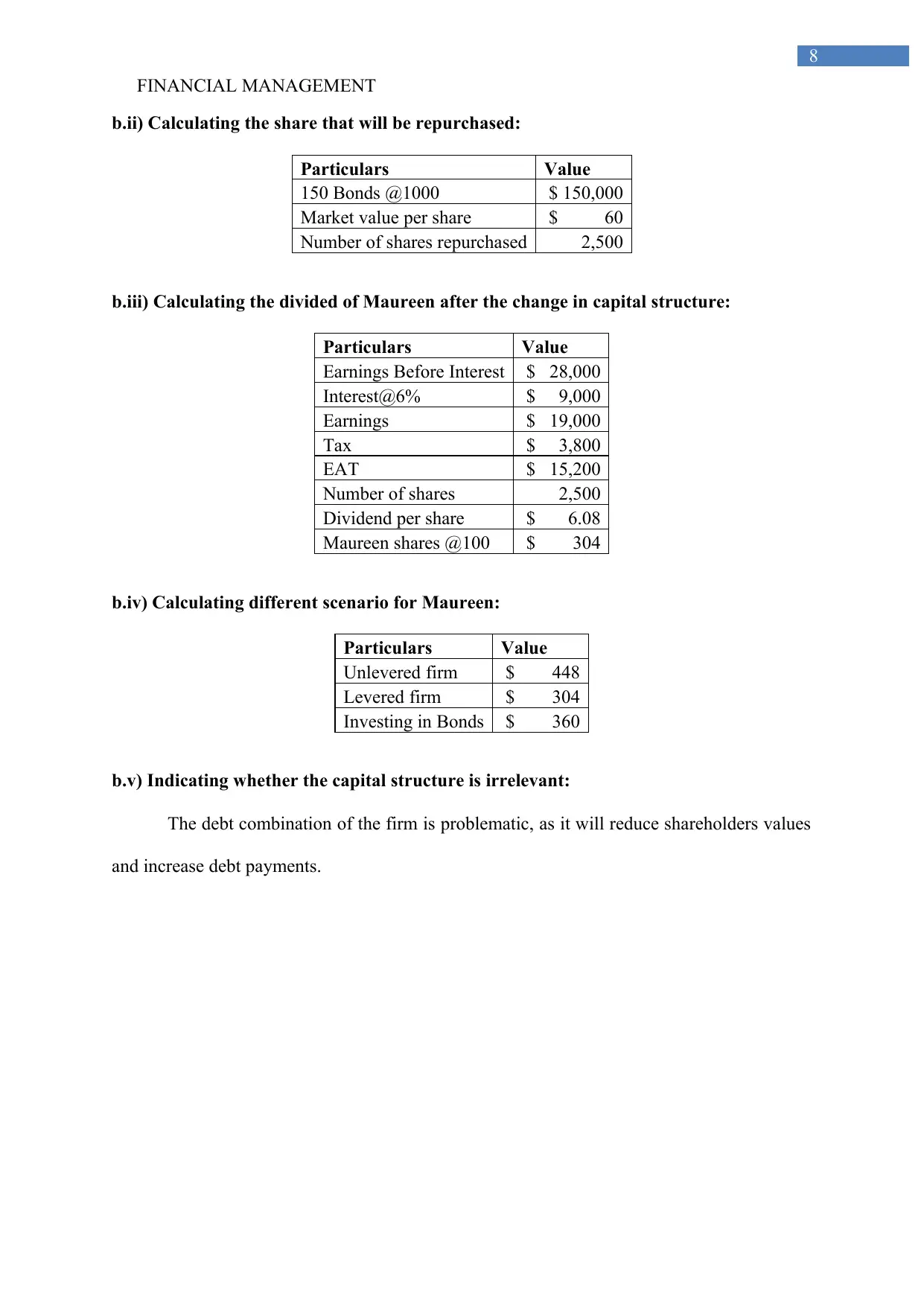
FINANCIAL MANAGEMENT
8
b.ii) Calculating the share that will be repurchased:
Particulars Value
150 Bonds @1000 $ 150,000
Market value per share $ 60
Number of shares repurchased 2,500
b.iii) Calculating the divided of Maureen after the change in capital structure:
Particulars Value
Earnings Before Interest $ 28,000
Interest@6% $ 9,000
Earnings $ 19,000
Tax $ 3,800
EAT $ 15,200
Number of shares 2,500
Dividend per share $ 6.08
Maureen shares @100 $ 304
b.iv) Calculating different scenario for Maureen:
Particulars Value
Unlevered firm $ 448
Levered firm $ 304
Investing in Bonds $ 360
b.v) Indicating whether the capital structure is irrelevant:
The debt combination of the firm is problematic, as it will reduce shareholders values
and increase debt payments.
8
b.ii) Calculating the share that will be repurchased:
Particulars Value
150 Bonds @1000 $ 150,000
Market value per share $ 60
Number of shares repurchased 2,500
b.iii) Calculating the divided of Maureen after the change in capital structure:
Particulars Value
Earnings Before Interest $ 28,000
Interest@6% $ 9,000
Earnings $ 19,000
Tax $ 3,800
EAT $ 15,200
Number of shares 2,500
Dividend per share $ 6.08
Maureen shares @100 $ 304
b.iv) Calculating different scenario for Maureen:
Particulars Value
Unlevered firm $ 448
Levered firm $ 304
Investing in Bonds $ 360
b.v) Indicating whether the capital structure is irrelevant:
The debt combination of the firm is problematic, as it will reduce shareholders values
and increase debt payments.
⊘ This is a preview!⊘
Do you want full access?
Subscribe today to unlock all pages.

Trusted by 1+ million students worldwide

FINANCIAL MANAGEMENT
9
Bibliography:
Bekaert, G. and Hodrick, R., 2017. International financial management. Cambridge
University Press.
DeAngelo, H. and Stulz, R.M., 2015. Liquid-claim production, risk management, and bank
capital structure: Why high leverage is optimal for banks. Journal of Financial
Economics, 116(2), pp.219-236.
Robb, A.M. and Robinson, D.T., 2014. The capital structure decisions of new firms. The
Review of Financial Studies, 27(1), pp.153-179.
Zeitun, R. and Tian, G., 2014. Capital structure and corporate performance: evidence from
Jordan.
9
Bibliography:
Bekaert, G. and Hodrick, R., 2017. International financial management. Cambridge
University Press.
DeAngelo, H. and Stulz, R.M., 2015. Liquid-claim production, risk management, and bank
capital structure: Why high leverage is optimal for banks. Journal of Financial
Economics, 116(2), pp.219-236.
Robb, A.M. and Robinson, D.T., 2014. The capital structure decisions of new firms. The
Review of Financial Studies, 27(1), pp.153-179.
Zeitun, R. and Tian, G., 2014. Capital structure and corporate performance: evidence from
Jordan.
1 out of 10
Related Documents
Your All-in-One AI-Powered Toolkit for Academic Success.
+13062052269
info@desklib.com
Available 24*7 on WhatsApp / Email
![[object Object]](/_next/static/media/star-bottom.7253800d.svg)
Unlock your academic potential
Copyright © 2020–2025 A2Z Services. All Rights Reserved. Developed and managed by ZUCOL.





